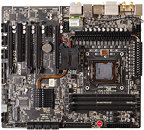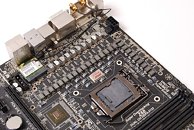- Joined
- Oct 9, 2007
- Messages
- 47,528 (7.48/day)
- Location
- Hyderabad, India
| System Name | RBMK-1000 |
|---|---|
| Processor | AMD Ryzen 7 5700G |
| Motherboard | ASUS ROG Strix B450-E Gaming |
| Cooling | DeepCool Gammax L240 V2 |
| Memory | 2x 8GB G.Skill Sniper X |
| Video Card(s) | Palit GeForce RTX 2080 SUPER GameRock |
| Storage | Western Digital Black NVMe 512GB |
| Display(s) | BenQ 1440p 60 Hz 27-inch |
| Case | Corsair Carbide 100R |
| Audio Device(s) | ASUS SupremeFX S1220A |
| Power Supply | Cooler Master MWE Gold 650W |
| Mouse | ASUS ROG Strix Impact |
| Keyboard | Gamdias Hermes E2 |
| Software | Windows 11 Pro |
ZOTAC entered the motherboard scene as yet another vendor of reference NVIDIA nForce motherboards, which the like of EVGA, XFX, and BFG also sold. After the fall of nForce, ZOTAC attempted a LGA1366 motherboard, and went dormant with motherboards. Later, it picked up interest in the mini-ITX form-factor as it gained popularity in Asian markets like China and India, manufacturing motherboards based on Intel Atom, Atom with NVIDIA ION, and eventually socketed mini-ITX motherboards as it became a 2-chip affair with Intel's Ibex Peak platform (LGA1156). It looks like Zotac is making a comeback into full-size ATX motherboards that target the very top tier of the market, to woo gamers, professional overclockers, and enthusiasts.
Seen here is what the Chinese press is referring to as "ZT-Z68 Crown Edition-U1DU3", we may have lost the correct name in translation, but let's call it ZT-Z68-U1DU3 for now. It is a full-size ATX motherboard that takes socket LGA1155 Intel Sandy Bridge and future Ivy Bridge processors, and is based on the Intel Z68 Express chipset. It combines a strong VRM to support extreme overclocking, with graphics expansion, adding 4-way NVIDIA SLI and AMD CrossFireX capabilities using an NVIDIA BR-03 bridge-chip that sits on the processor's PCI-E x16 link, to give out two PCI-Express 2.0 x16 links, which are then spread between four slots in x16/NC/x16/NC, x16/NC/x8/x8, or x8/x8/x8/x8 lane configurations.




The LGA1155 socket is powered by a 24-phase VRM that makes use of driver-MOSFETs, solid chokes, high-C and super ML capcitors to condition power. The memory is powered by a 2-phase design. Dual-channel DDR3 memory with speeds of over 2133 MHz with overclocking is supported. Apart from the four PCI-Express 2.0 slots explained earlier, there is one each of PCI-E x1 and PCI.
Storage connectivity includes eight internal SATA ports, which includes 6 Gb/s, 3 Gb/s ports; and an mSATA port to hold a SSD card to help with Intel Smart Response technology. Overclockers might find it particularly convenient to use just a medium-sized SandForce-driven SSD in the mSATA slot, getting rid of one set of cables. There's even an IDE to run the old DVD drives. There is an eSATA port in the rear panel. There are six USB 3.0 ports, two on the rear panel, four by internal headers.
Other connectivity includes 8-channel HD audio, Gigabit Ethernet, and wireless b/g/n. The board features three socketed serial flash ROM chips to house three sets of redundant UEFI firmware. Pricing and availability is not known, but one thing is for sure, this board is looking to go places.
View at TechPowerUp Main Site
Seen here is what the Chinese press is referring to as "ZT-Z68 Crown Edition-U1DU3", we may have lost the correct name in translation, but let's call it ZT-Z68-U1DU3 for now. It is a full-size ATX motherboard that takes socket LGA1155 Intel Sandy Bridge and future Ivy Bridge processors, and is based on the Intel Z68 Express chipset. It combines a strong VRM to support extreme overclocking, with graphics expansion, adding 4-way NVIDIA SLI and AMD CrossFireX capabilities using an NVIDIA BR-03 bridge-chip that sits on the processor's PCI-E x16 link, to give out two PCI-Express 2.0 x16 links, which are then spread between four slots in x16/NC/x16/NC, x16/NC/x8/x8, or x8/x8/x8/x8 lane configurations.




The LGA1155 socket is powered by a 24-phase VRM that makes use of driver-MOSFETs, solid chokes, high-C and super ML capcitors to condition power. The memory is powered by a 2-phase design. Dual-channel DDR3 memory with speeds of over 2133 MHz with overclocking is supported. Apart from the four PCI-Express 2.0 slots explained earlier, there is one each of PCI-E x1 and PCI.
Storage connectivity includes eight internal SATA ports, which includes 6 Gb/s, 3 Gb/s ports; and an mSATA port to hold a SSD card to help with Intel Smart Response technology. Overclockers might find it particularly convenient to use just a medium-sized SandForce-driven SSD in the mSATA slot, getting rid of one set of cables. There's even an IDE to run the old DVD drives. There is an eSATA port in the rear panel. There are six USB 3.0 ports, two on the rear panel, four by internal headers.
Other connectivity includes 8-channel HD audio, Gigabit Ethernet, and wireless b/g/n. The board features three socketed serial flash ROM chips to house three sets of redundant UEFI firmware. Pricing and availability is not known, but one thing is for sure, this board is looking to go places.
View at TechPowerUp Main Site
Last edited by a moderator:



 with almost no oc options available
with almost no oc options available


